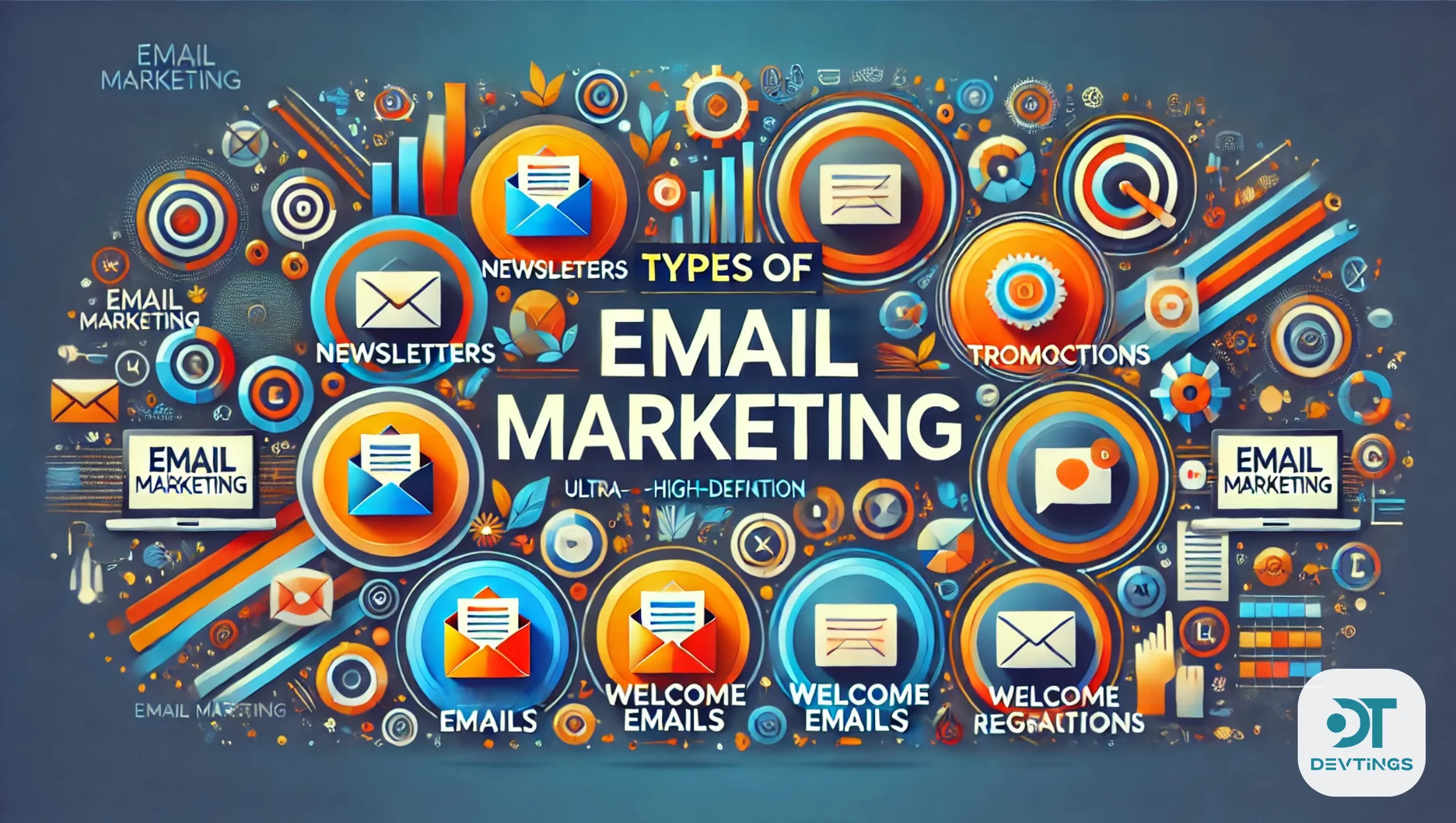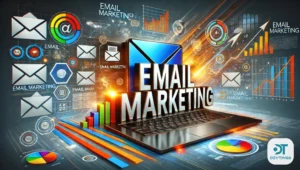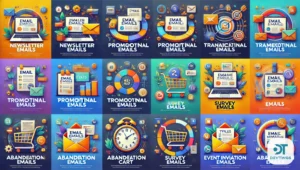Types of Email Marketing
Email marketing continues to be one of the most essential components of a digital marketing strategy, providing unmatched and creative ways to engage canvassed audiences, nurture leads, and enable conversions. In order to create campaigns catered to your target audience, and that support your business objectives, it’s important to understand the different kinds of email marketing.
What is Email Marketing?
Email marketing is basically the act of sending email messages to your target or prospect on regular basis to promote your product, share information, and even building relationship. Being a direct method of communication, businesses usually target their audience in a personalized manner. These technologies can be used, for example, to ease this process through tools like dynamics CRM email marketing to power efficient campaign management and automation.
Main Types of Email Marketing
Building a comprehensive strategy will require us to understand the different types of email marketing campaigns. There is one type that serves to make certain goals and can be tuned to work with specific marketing objectives.
Transactional Emails
Automated messages, triggered with user actions, are called transactional emails. These are e.g. order confirmations, shipping notifications or password reset emails. These are not easy emails to trim, since they’re important and recipients expect them, which means they’ve got a tremendous opportunity to further reinforce brand trust.
Promotional Emails
Promotional emails keep subscribers informed on special offers, new products, or services. They are meant to encourage people to buy and act quickly. For example, with construction marketing email templates, businesses can develop dynamic emails featuring their most recent projects or services in a way that’s visually appealing.
Drip Campaigns
A drip campaign is simply a series of automated emails that are sent over a certain length of time. They are commonly leveraged for nurturing leads through the provision of great content that causes recipients to eventually become purchase decision makers. For example, a subscriber who downloads an email marketing PDF Book will be emailed follow up emails offering more resources or related services.
Newsletters
Newsletters are emails sent at regular intervals to current subscribers who have signed up in order to inform them of company news, industry updates and other valuable information. They ensure your audience stays engaged. For example, an accounting firm may use accountant email marketing newsletters to send out tax tips, financial advice and ways that the regulations are changing.
Re-Engagement Emails
Engagement emails are sent to your inactive subscribers with the goal of rekindling their interest in your brand. Your recipients might respond positively to these emails, which include offer special incentives, solicit for feedback or to announce new offerings..
Affiliate Emails
The types of affiliate emails are those of promoting products or services of partner companies and you being rewarded with a commission for any sales done through you as a referral. If you want to use affiliate marketing within your email campaigns, combine it with email & affiliate marketing mastermind strategies.
Seasonal Campaigns
Time sensitive emails based on any holiday or event or the season(s). By using the occasion and its urgency and relevance, they engage customers and drive sales. Examples are Black Friday promotions, Holiday greetings, Back to school offers, etc.
Best Practices for Email Marketing
To maximize the effectiveness of your email marketing efforts, consider the following best practices:
- Personalization: Personalize your content and use the recipient’s name.
- Segmentation: Segment your email list by demographics or people who’ve interacted with your product or been loyal purchasers.
- A/B Testing: Try different subject lines, email designs, and content and see what your with your audience.
- Clear Call-to-Action (CTA): Make sure that each email has a clear and compelling CTA that points the reader where you actually want them to go.
- Mobile Optimization: Send responsive and mobile friendly emails, with good look.
Advantages and Disadvantages of Email Marketing
Understanding the pros and cons of email marketing can help you develop a balanced and effective strategy.
Advantages
- Cost-Effective: Compared to other marketing channels, email marketing is very inexpensive.
- Measurable: You can see how the performance of your campaigns has performed on open rates, click through rates and conversions.
- Targeted: It enables you to target and segment with greater precision, therefore your messaging is more appropriate.
- Scalable: It can easily be scaled to address large audiences or completely customized based on small, targeted audiences.
Disadvantages
- Deliverability Issues: If you don’t know how to manage emails properly, they might land in your spam folder.
- Overcrowded Inboxes: Competition for attention in the receivers’ inboxes.
- Design Constraints: It gives us limited design capabilities compared to other types of media, such as print or web pages.
- Regulatory Compliance: They must follow laws such as GDPR which can make campaigns complicated.
Tools to Elevate Your Email Marketing
Leveraging the right tools can enhance the efficiency and effectiveness of your email marketing campaigns.
- Dynamics CRM Email Marketing: Combines customer relationship management with email marketing to send custom and automated campaigns.
- Mailchimp: A popular platform that offers user friendly interfaces, has automation features and also analytics to track performance.
- Constant Contact: It gives you customized templates, list management and reporting features that are good enough for small businesses.
- SendinBlue: Provides email marketing, SMS marketing and powerful built in chat capabilities alongside robust automation tools.
How to Create an Effective Email Marketing Campaign
Developing a successful email marketing campaign involves several key steps:
- Set Clear Objectives: Then you begin with a specific goal such as higher sales, bigger subscriber list, or more traffic to your website.
- Identify Your Audience: Work in accordance with the target audience preferences using buyer personas to tailor your campaign.
- Select the Right Tools: Mailchimp, Dynamics CRM or Constant Contact are the platforms to manage and automate your campaigns.
- Craft Engaging Content: Write attention grabbing subject lines, personalize messages, and use strong calls to action (CTA) in order to get your subscribers to take action.
- Optimize for Mobile: Make sure you adjust your email templates to be viewed on mobile devices, since most people can spend at least a little time on their phones to check their emails.
- Test Your Campaign: Experiment with A/B testing to figure out what subject lines perform the best, graphics or an effective CTA (call to action button).
- Analyze Results: Measure your campaign performance by open rates, click through rates and conversions, and use data when modifying future campaigns.
FAQs About Email Marketing
Here are some of the most searched questions about email marketing and their answers to guide you:
- What is email marketing automation?
It means sending targeted, personalized emails at the right time with tools, without manual effort. Mailchimp and Microsoft Dynamics CRM are the best tools to dig out the cost from your marketing automation while eliminating the risk. - How can I create a successful email marketing funnel?
Deliver a lead magnet (e.g. eBook or free trial), start drip campaigns, give value, and slide them into a purchase. - How do I build an email list quickly?
Offer incentives like discounts, exclusive content, or free resources. Capture leads from sign up forms on your website, pop ups, or by running social media campaigns. - What are the best practices for email subject lines?
Make them short, intriguing and relevant. Personalize the letter – include the recipient’s name – and give a sense of urgency or curiosity. - How do I avoid email spam filters?
Don’t use words that are spammy like ‘free,’ ‘urgent’, use a professional email address, include an unsubscribe link and make sure your content is relevant and valuable. - What are the legal requirements for email marketing?
Laws like GDPR and CAN-SPAM require explicit consent from recipients, an option to unsubscribe, and clear sender information. - How do I measure the success of an email campaign?
Track open rates, click through rates, conversion and ROI. From here, use these insights to improve on future campaigns. - How often should I send marketing emails?
That depends on your audience and objectives. But be weekly or bi-weekly and be consistent without bogging down your subscribers! - How can I earn money from email marketing?
Affiliate marketing is one way you can earn, promoting others’ products or services, or by using your emails as a place to sell ad space to other businesses. - How do I write effective email marketing content?
Focus on value. Talk about your audience’s pain points and show how you can solve them, followed by a clear and powerful call to action. - How do I use email marketing to retain customers?
Create loyalty rewards, reengage campaigns, and even send a thank you note to customers through personalized emails. - What is the best email marketing platform for beginners?
Because of its user friendly interface and free plan option for small lists Mailchimp is a popular option when you are just beginning.
Conclusion
It is undeniable that email marketing is still a crucial weapon for businesses big or small. So if you want to take your online email marketing efforts to the next level—and see better results—first understand the different types of email campaigns (vacation emails, transactional emails, newsletters, and affiliate emails) and then apply best practices like targeting subscribers with personalization and segmentation.
You can use such tools as Dynamics CRM for email marketing and construction email marketing templates to automate all the processes. If you persist in being consistent and analyze the results, you will form a stronger bond with your audience to improve engagement and conversions.
On your part, you are ready to bring your email marketing at a whole new level. Experience the transformative power of targeted communication! Start today!









